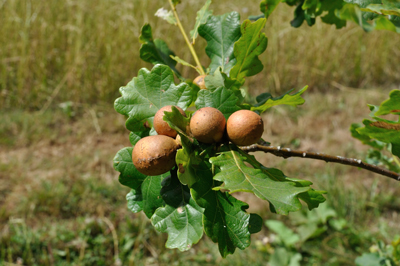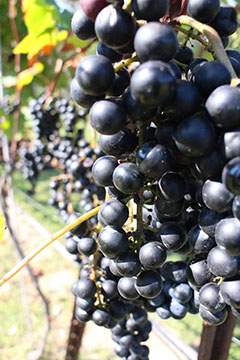
You can see it right there in the name: Tannins. From an Old High German word for oak or fir tree, these materials are grouped together for their fundamental ability to tan hides. That is, they can turn raw animal skin into leather by binding with proteins and making them insoluble in water. That is sort of what they are doing in your mouth when you take a sip of astringent red wine. As Harold McGee puts it in his famous book On Food and Cooking: “The sensation of astringency is caused by the ‘tanning’ of proteins in the saliva and mucous membranes of the mouth; lubrication is reduced and the surface tissues actually contract.”
Since that does not sound very pleasant, why are we eager to have tannins in our wine? Astringency and bitterness from various polyphenolic compounds, mainly tannins, help balance sweetness and fruitiness to prevent a cloying sensation. The astringency also adds to the physical impact of the wine, contributing (along with alcohol and acidity) to the characteristic called “body.” Tannins also play roles in preventing premature oxidation in wine as well. They incorporate oxygen from the wine to facilitate polymerization (linking up) of individual tannin molecules to make bigger ones. This prevents more harmful oxidative reactions, while mellowing and rounding out the wine.
Tannins also assist in stabilizing color. Early in maceration and fermentation, some of the color compounds — other polyphenolics called anthocyanins — may bind with proteins in the grapes and drop out as sediment. If tannins are present, some of them will bind with the proteins instead in a role called “sacrificial tannins.” Tannins also bind directly with anthocyanins to form stable dissolved pigments to help preserve color. Grape tannins are present in seeds, stems, and skins but are almost absent from juice and pulp. Since most of white winemaking is done without seeds or stems, tannins tend to be very low in whites. Rosés have a bit more from skin contact, but they are also fermented without seeds. In reds, stems are generally removed and the greatest portion of tannins comes from seed contact, with a smaller amount from skin maceration.
Tannins are also extracted from wood during barrel aging or aging with oak alternatives. Beyond those fairly conventional products, there is a whole array of specific tannin products for particular applications. Since wooden barrels and tanks have been used in wine production for hundreds of years, wood and wood derivatives are widely approved for use in winemaking. As you might expect, many of these are made from oak. It may be finely powdered wood, or a liquid or dry extract of wood. The oak may be toasted or not. Oak gallnuts, a growth on the tree that results from attack by a wasp, provide a different range of tannins that can be found in some wine addition products. Today, even woods without specific wine heritage are contributing tannin products to the field. One of these, the South American hardwood quebracho tree, was first identified for its hide-tanning properties. Chemical characteristics of quebracho tannins closely resemble those of grapes, making it a desirable potential addition for winemakers. Citrus tree woods contain fruity aromatic compounds that are bound to sugar molecules (glycosides) and not detectable in wine. However, when acted upon by yeast enzymes during fermentation, those compounds may be released, enhancing fruity aromas.
You can add tannin products to whites or rosés to stave off premature oxidation, improve mouthfeel, and contribute desirable aromas. In reds, more robust products may be applied that add a woody note, build mouthfeel, or stabilize color. During aging, tannin additions can help resist oxidation, contribute to roundness from polymerization, and improve mouthfeel. Near bottling, direct tannin additions can contribute some of the aroma and flavor components typical of oak barrels such as coconut, vanilla, and smoke.
In general, tannins are used relatively spargingly. Often as little as 5–50 g/hL of juice (grams per hectoliter or grams per 100 L; these rates equate 0.2–2 g/gal) will do the trick. So be sure to refer to the manufacturer’s instructions before their use.
Fermentation Tannins
• White wine (or rosé). Scott’Tan FT Blanc Soft from Scott Laboratories is an oak gallnut tannin product. It contributes a soft, round mouthfeel and may impart a perception of sweetness. In use, you sprinkle it directly on the fruit in the crusher or add it to juice during the first racking. Scott also offers FT Blanc, which is also derived from oak gallnuts and is recommended where conditions are a bit more difficult, such as the presence of mold or in high-protein musts. It will inhibit browning caused by laccase activity from mold and will precipitate proteins. Application and dosing is the same as for FT Blanc Soft. A product from ATP Group, Gallic-Tan, is also recommended for mitigating the effects of laccase oxidation from mold. It should be added to the juice or wine during mixing. Enartis produces their Tan Blanc, a gallic tannin extract recommended for prevention of oxidation throughout the fermentation and aging of white wines.
Scott FT Blanc Citrus combines gall nut tannins with citrus wood tannins. It is directed at enhanced aromatic profiles, with wines often showing apple, floral, and citrus notes. It is added after fermentation begins, generally 24–48 hours after yeast inoculation. Enartis Tan Citrus is a tannin extract of acacia and lemon wood directed at enhancing aroma. Because its effects are dependent on yeast activity, it must be applied during fermentation. It is added about 1⁄3 of the way through active fermentation.
• Red wine. At the most basic level, oak wood can be added directly to a red wine fermentation as powder, chips, or cubes. For specific tannin products, Enartis Tan V is an extract of non-fermented grape seeds that is intended to quickly react with anthocyanins to form stable colors. It needs to be added at the beginning of maceration. Color Tan NT from ATP includes gallic tannins and is described as especially appropriate for more delicate reds such as Pinot Noir or Merlot because it does not mask fruit character with woody notes. It stabilizes color and improves mouthfeel of the wine. Scott’Tan FT Rouge Soft is the red-wine product that corresponds to FT Blanc Soft. It is derived from quebracho wood and is also recommended for more delicate red varieties. Add it directly to fruit in the crusher or at first punchdown. A similar product, FT Rouge, adds chestnut tannins to the mix and is applied at the same rates.
Cellaring Tannins
• White wine. Some of the white wine fermentation tannins can be applied as a second dose to minimize oxidation after fermentation. In addition, products like Scott’Tan Tannin Refresh can be applied to white wines during aging to simulate some of the effects of oak-barrel aging. It is derived from untoasted French oak and imparts a slight woody character without smoke or toast. It also helps prevent oxidation during aging. Enartis Tan Skin is extracted from the skins of pressed (but not fermented) white grapes. It improves aromas, increases mouthfeel, and complexity when added after fermentation is complete.
• Red wine. Enartis Tan Microx is extracted from grape seeds and untoasted oak. It is applied during aging to help with stabilization of color, building of wine structure, and suppression of herbaceous character. Scott’Tan Tannin Complex is derived from oak and quebracho. It is more thoroughly polymerized than some other products, so less immediately reactive. It has stabilizing effects similar to Microx and is applied at the same rate. ATP’s Querca-Tan Rouge is derived from lightly toasted barrel-quality wood from oak species Quercus robur and Quercus petraea. In addition to stabilizing color and minimizing oxidation, it contributes a mild oak aroma.
Finishing Tannins
These products impart an explicit toasted oak character to the wine and as such, they are more often used in reds. I have had good success with one such product when coping with a “donut-hole” red wine: one with good fruit and a good finish, but lacking body and mouthfeel in the mid-palate. That product is Tannin Riche from Scott Labs, derived from 100% toasted French oak (Tannin Riche Extra is the corresponding product from American oak). It can be added as late as three weeks before bottling and has immediate effects on the wine. It imparts hints of vanilla and coconut while filling out some additional body on the palate. You may note a touch of sweetness on the finish. A lower dose may be applied to white or rosé if you want to impart an oaky note shortly before bottling. Tani-Heritage from ATP is also derived from toasted wood and may be applied to finished wine.
All of the above are completely natural products and you need not hesitate to use them when you can improve your wine. Several of the products are also recommended for cider, fruit wine, and mead. Give tannins a try!






